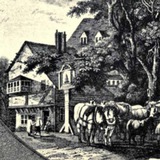Forwarded from Vinnie Sullivan
White Hart public house once sat on #Hackney Marshes (on the road to #Leyton) which is now the #Olympic site. This site is close to where I was born & lived my life. Having been born in modern times, I'll never know what it was really like. @Britains___Pubs
🎨 A.G. Stout, 1896.
🎨 A.G. Stout, 1896.
Britain's Pubs [Page 2/2] (Part of Britain's Lost & Living Pub Series)
White Hart public house once sat on #Hackney Marshes (on the road to #Leyton) which is now the #Olympic site. This site is close to where I was born & lived my life. Having been born in modern times, I'll never know what it was really like. @Britains___Pubs…
The White Hart, on the #RiverLea at #TempleMills, #Hackney Marshes by J.T. Wilson
The painting faces the White Hart where we can see in the foreground, horses pulling a heavily-laden cart of straw through water.
https://t.me/vinniesullivan/27321
The painting faces the White Hart where we can see in the foreground, horses pulling a heavily-laden cart of straw through water.
https://t.me/vinniesullivan/27321
Britain's Pubs [Page 2/2] (Part of Britain's Lost & Living Pub Series)
The White Hart, on the #RiverLea at #TempleMills, #Hackney Marshes by J.T. Wilson The painting faces the White Hart where we can see in the foreground, horses pulling a heavily-laden cart of straw through water. https://t.me/vinniesullivan/27321
White Hart, Temple Mill Lane, #HackneyMarsh, #Hackney, #E15
#RIP ⚰️
Possibly established by 1513, demolished in 1999, we shall never see it's kind again. Originally listed under #Stratford, and previously under #Leyton, the spot is now the Olympic site, meaning we can't see any traces what so ever. This is near where I grew up (@VinnieSull1van), and it's sad to think of what it's become. Next drink you have, think of the White Hart.
https://t.me/vinniesullivan/27321
https://t.me/BritainsPubs/1418
#RIP ⚰️
Possibly established by 1513, demolished in 1999, we shall never see it's kind again. Originally listed under #Stratford, and previously under #Leyton, the spot is now the Olympic site, meaning we can't see any traces what so ever. This is near where I grew up (@VinnieSull1van), and it's sad to think of what it's become. Next drink you have, think of the White Hart.
https://t.me/vinniesullivan/27321
https://t.me/BritainsPubs/1418
An image of old pub tokens from #Hackney public-houses dating from 1830. They were usually struck in brass, or copper or white metal, and had a diameter of 28 mm. A key use for tokens (among other reasons) was to prevent staff pocketing money/change. Notice they even have little holes, meaning they were once worn on a belt (made of string).
